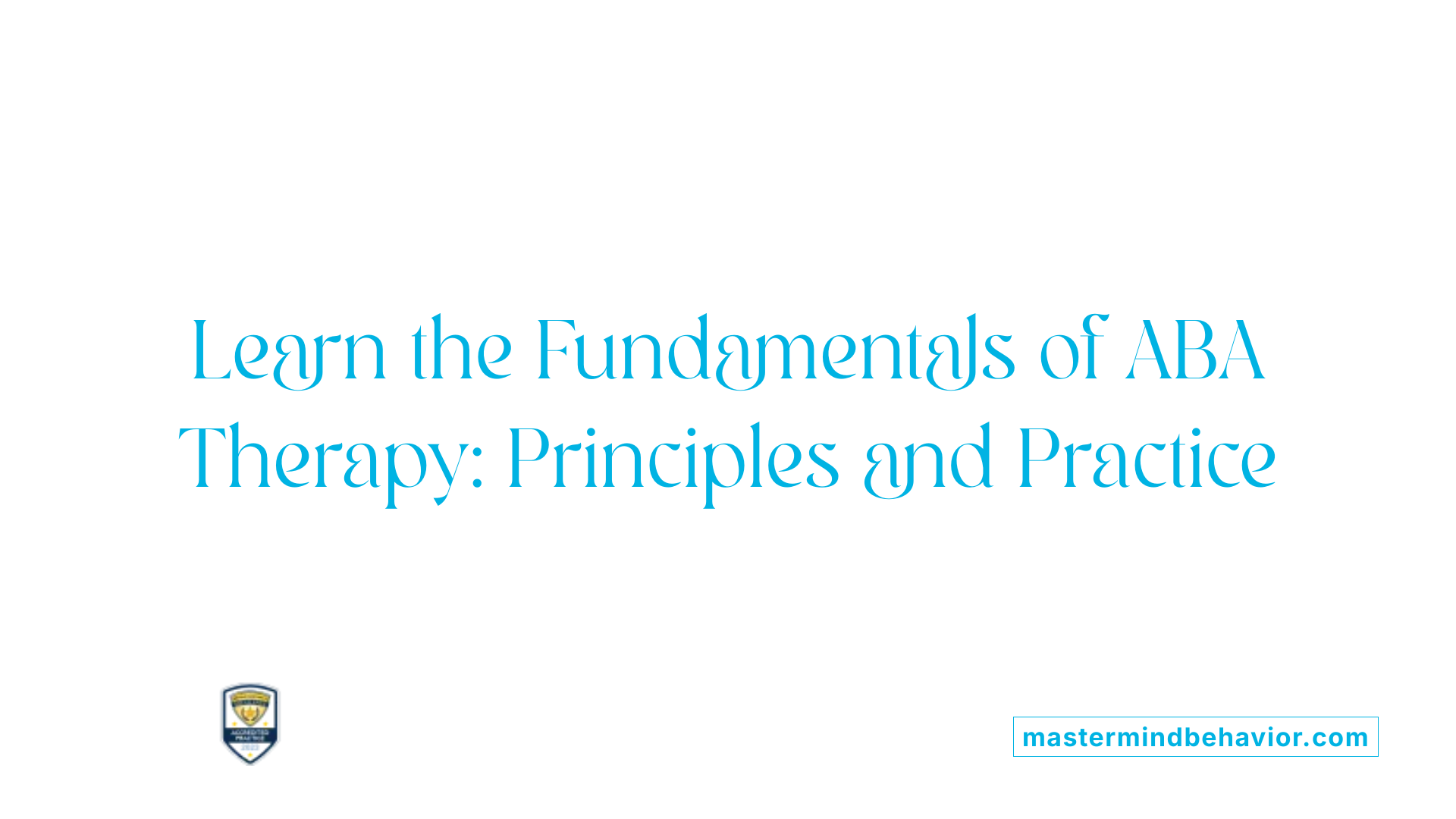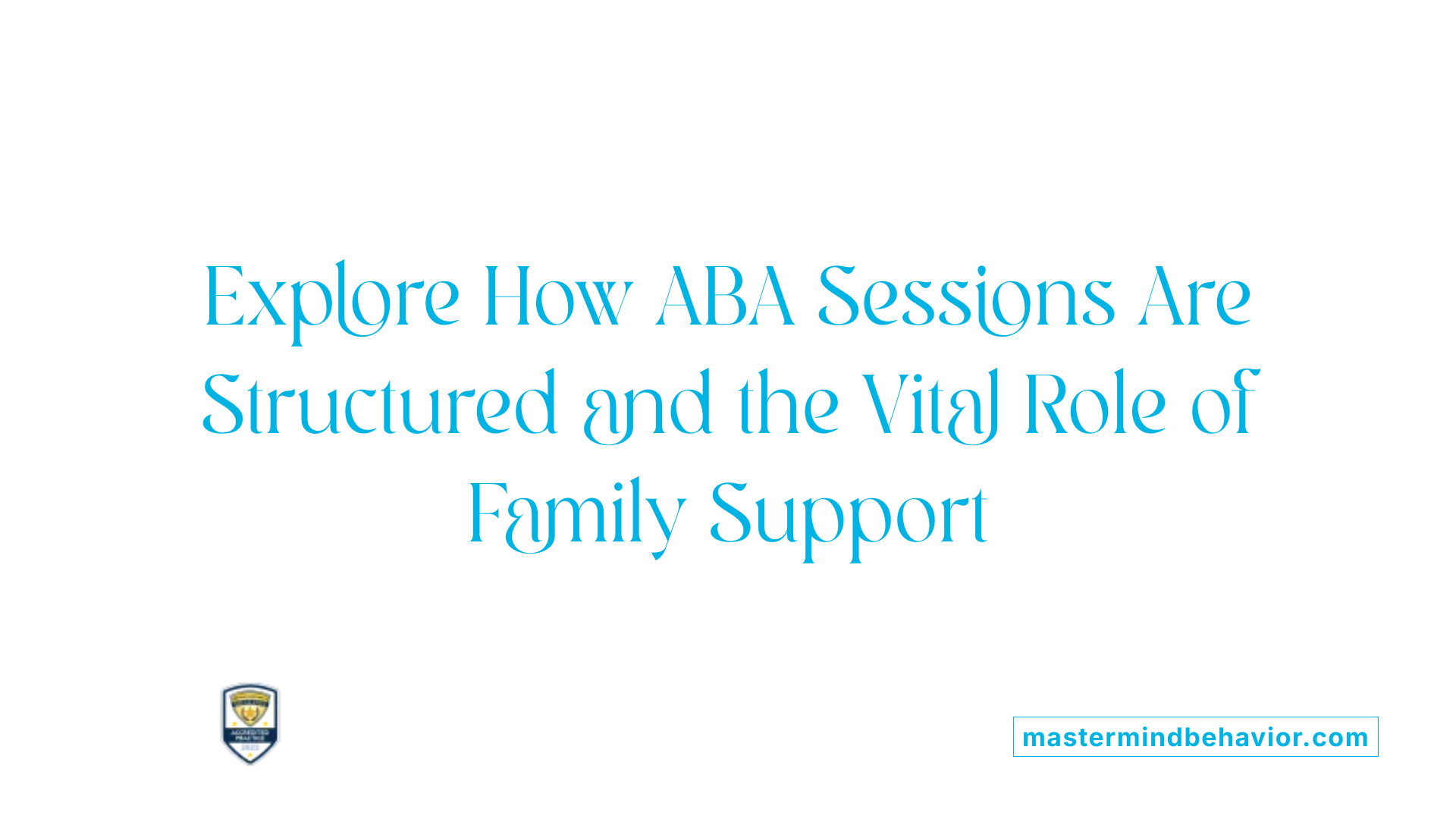Understanding ABA Therapy and Its Foundations
ABA therapy, or Applied Behavior Analysis, is a scientifically-backed approach widely used to foster skill development in individuals with autism and other behavioral conditions. By analyzing and modifying behaviors through structured interventions, ABA helps children and adults alike learn new skills, improve communication, and manage emotional responses. This article explores how ABA therapy encourages the flexible use of coping strategies essential for emotional resilience and daily functioning.
What is Applied Behavior Analysis (ABA) Therapy?

Definition of ABA Therapy
Applied Behavior Analysis (ABA) therapy is a scientifically based intervention designed to improve specific behaviors. It focuses on understanding how behavior is influenced by the environment and uses this insight to encourage helpful skills like communication and social interaction while reducing undesired behaviors.
Scientific Basis and Principles
ABA relies on principles of learning theory, particularly the ABC model—Antecedent, Behavior, and Consequence—to analyze and shape behavior. By applying positive reinforcement, such as praise or small treats, desired behaviors become more frequent, making this approach both measurable and effective.
Customized Programs and Role of Behavior Analysts
Each ABA program is tailored to individual needs, goals, and preferences. Qualified behavior analysts conduct thorough assessments, identify target behaviors together with caregivers, and continually monitor progress. This ensures the therapy aligns with the child’s evolving needs and maximizes positive outcomes.
Therapy Settings
ABA therapy can be delivered in multiple environments, including at home, in schools, community settings, or even remotely. This flexibility supports the transfer of learned skills across natural settings, helping children generalize behaviors and increase their independence.
How ABA Enhances Communication and Emotional Regulation
What improvements in communication skills does ABA therapy offer?
ABA therapy uses a structured and measurable approach to help children with autism enhance their communication skills. Early sessions focus on simple goals such as listening and imitating sounds or words. Over time, this foundation supports the development of more complex abilities like reading, conversation, and interpreting social cues. Through breaking down communication tasks into smaller, manageable steps, ABA helps children initiate interactions, respond appropriately in social settings, and build friendships.
How does ABA support emotional regulation in autistic children?
ABA therapy boosts emotional regulation by teaching children to recognize and manage emotions, including stress and social anxiety often experienced in early intervention phases. Positive reinforcement strategies encourage the development of coping mechanisms such as managing stress and interpreting facial expressions. This leads to increased emotional resilience and self-esteem, creating a foundation for better handling of daily challenges.
Why are structured routines important in ABA therapy?
Structured routines are a vital part of early ABA intervention. They create a predictable environment where children can learn and practice new skills consistently. This structure reduces behavioral issues like tantrums and fosters a sense of safety and control. As children succeed within these routines, confidence grows, enabling them to apply skills in more flexible settings.
How does early intervention in ABA influence developmental progress?
Starting ABA therapy early offers significant benefits. Early intervention targets developmental areas such as language, cognitive functioning, and social skills, setting the stage for long-term improvements. By working closely with families and tailoring goals to individual needs from the outset, ABA minimizes the impact of challenging behaviors and accelerates meaningful progress.
What role does positive reinforcement play in ABA?
Positive reinforcement is at the heart of modern ABA practices. Instead of punishment, ABA uses rewards like praise or small treats to encourage desirable behaviors. The ABC model (Antecedent-Behavior-Consequence) guides the process, ensuring that positive behaviors are consistently recognized and strengthened. This approach not only increases the frequency of beneficial skills but also fosters motivation and engagement in therapy.
How does ABA therapy benefit individuals with autism?
ABA therapy benefits individuals with autism by providing a scientifically supported approach to enhancing essential skills such as communication, social interaction, academic performance, and daily living. It uses personalized plans and positive reinforcement to reduce challenging behaviors and promote independence. Early and intensive ABA interventions have shown to lead to significant developmental gains and improved quality of life through increased socialization and integration.
The Structure of an ABA Therapy Session and Family Involvement

What does an ABA therapy session usually involve?
An ABA therapy session is carefully designed to support each child's unique needs through structured, individualized activities. These sessions often include play-based tasks such as puzzles, sensory play, singing, and story reading. These activities help children develop essential communication, social, and daily living skills in an engaging way.
Positive reinforcement is the cornerstone technique during sessions. Therapists reward desired behaviors with praise, small treats, or preferred activities to encourage repetition of those behaviors. This approach helps reduce challenging actions while promoting skill growth.
Role-playing and modeling play significant roles in teaching social skills and everyday routines. By simulating real-life scenarios, children practice communication, interpreting social cues, and problem-solving in a supportive environment. Incorporating natural environment teaching ensures children can generalize skills to real-life settings.
Family involvement is integral to ABA therapy's success. Parents and caregivers participate actively by learning strategies to support the child's progress at home and in daily routines. Consistent collaboration between therapists and families tailors therapy sessions to the child's evolving interests and developmental goals.
Overall, ABA sessions balance structured teaching with interactive play and parental partnership, creating a nurturing setting that encourages skill acquisition, emotional growth, and independence.
The Role of Positive Reinforcement in Developing Coping Strategies
What is Positive Reinforcement in ABA Therapy?
Positive reinforcement is a fundamental principle in Applied Behavior Analysis (ABA) therapy where desired behaviors are encouraged through rewards. Rather than using punishment, ABA leverages rewards like praise or small treats to increase the likelihood that positive behaviors will occur again.
How Are Reward Systems Used?
Reward systems in ABA are carefully designed to motivate children. For example, when a child successfully communicates a need or follows a social cue, they might receive verbal praise or a preferred item. This consistent reinforcement helps embed new skills by linking behaviors with positive outcomes.
How Does Positive Reinforcement Help Reduce Problematic Behaviors?
By reinforcing appropriate behaviors, ABA therapy decreases the occurrence of challenging behaviors such as tantrums or avoidance. Instead of focusing on the undesirable actions, the therapy redirects attention toward constructive ones, making negative behaviors less frequent over time.
How Does Positive Reinforcement Increase Adaptive Behaviors?
Reinforcement not only reduces problematic behaviors but also actively promotes adaptive skills. These include effective communication, independent daily living activities, and social interaction abilities. Such skills build a child's confidence and emotional resilience in various settings.
What Coping Skills Are Developed Through Positive Reinforcement?
ABA therapy helps children develop lasting coping strategies like managing stress, recognizing facial expressions, and initiating social interactions. These skills enable them to better adapt to social environments, regulate their emotions, and respond to challenges effectively.
Developing Emotional Resilience and Self-Esteem through ABA

How does ABA therapy boost emotional resilience?
ABA therapy supports emotional resilience by using positive reinforcement and individualized approaches that cater to each child's unique needs. Through structured sessions, children learn to manage stress, recognize facial expressions, and initiate social interactions, which are critical coping strategies. This tailored support helps children better navigate their environment and respond in adaptive ways to emotional challenges.
In what ways does ABA build confidence?
By focusing on positive behaviors and rewarding small achievements, ABA therapy significantly enhances a child's confidence. As children master new skills—ranging from communication to daily living tasks—they experience increased independence and self-esteem. These successes encourage a more proactive and optimistic attitude toward social engagement and learning.
Why are individualized approaches and family participation important?
Individualized ABA programs ensure interventions align with a child's developmental level and personal goals, maximizing effectiveness. Additionally, involvement from family members is crucial; their active participation in setting goals and reinforcing new skills at home fosters consistency and a supportive environment. This collaboration helps maintain emotional well-being and strengthens the therapy's positive impact.
What are the long-term emotional benefits of ABA?
Long-term benefits extend beyond immediate behavioral improvements. Effective ABA therapy fosters lasting emotional resilience, improving confidence and promoting autonomous functioning. Children often demonstrate enhanced emotional regulation and a greater ability to cope with stress, which supports improved social relationships and overall well-being throughout their lives.
Ethical Considerations and Individualized Treatment Planning
Why Are Ethical Practices Important in ABA Therapy?
Ethical practices ensure that ABA therapy is delivered respectfully and safely, prioritizing the child's well-being. Proper ethical standards help minimize stress, social anxiety, and any unintended negative psychological effects during therapy, especially in early intervention stages.
Who Provides ABA Therapy?
ABA therapy is typically provided by trained professionals such as Board Certified Behavior Analysts (BCBAs) and registered behavior technicians (RBTs). These experts design and implement personalized treatment plans that fit each child's unique needs. Family members often play an active role, receiving guidance to reinforce progress outside therapy sessions.
How Is ABA Therapy Tailored to the Individual?
Therapists use continuous assessment to identify target behaviors for each child and break down complex tasks into manageable steps. They employ the ABC model—Antecedent, Behavior, Consequence—to shape behaviors through positive reinforcement, adjusting plans as the child develops.
What Role Does Family Involvement Play?
Families are integral to successful ABA therapy. Their involvement ensures consistent practice of skills across home and community settings, boosting emotional resilience and reinforcing positive behaviors. Regular collaboration between therapists and families encourages shared decision-making and supports long-term progress.
How Does Ethical ABA Minimize Stress and Anxiety?
Ethical ABA therapy emphasizes positive reinforcement rather than punishment, creating a supportive environment that fosters confidence and reduces anxiety. Tailored interventions account for individual sensitivities and needs, gradually building coping strategies that enhance emotional well-being and independence.
Adaptability and Flexibility: ABA Across Diverse Needs and Settings

How Adaptable Is ABA Therapy?
ABA therapy is highly adaptable, tailored to meet the unique needs of each individual. This personalization allows for the modification of treatment plans based on the child's behavior, learning style, and developmental stage. By breaking down complex tasks into manageable steps and applying positive reinforcement techniques, therapists help children build essential skills in a way that suits them best.
Can ABA Be Used for Different Age Groups?
Yes, ABA therapy is suitable for individuals across all ages, from toddlers to adults. Early intervention, especially during toddler years, focuses on boosting language, cognitive, and social skills. For older children and adults, the therapy can address more complex behaviors and support the development of daily living skills and independence.
In Which Settings Is ABA Therapy Delivered?
ABA can be effectively administered in several environments:
- Home: Allows for naturalistic learning within familiar surroundings.
- School: Integrates skill-building into academic and social activities.
- Community: Promotes real-world application of learned skills.
- Remote: Offers flexibility and access when in-person sessions aren’t possible. This flexibility ensures therapy can be consistent and relevant across the child’s daily environments.
What About Co-Occurring Conditions?
ABA is not limited to autism spectrum disorders. It also supports individuals with ADHD, OCD, anxiety, PTSD, and other mental health conditions. This broad applicability is due to ABA’s focus on modifying behaviors through reinforcement strategies tailored to the individual's specific needs.
How Does ABA Promote Generalization of Skills?
One vital aspect of ABA is helping children generalize newly learned skills beyond therapy sessions. By practicing behaviors across different settings and situations, such as home and community, children learn to apply communication, emotional regulation, and social skills more broadly. This encourages lasting improvements in daily life, enhancing independence and confidence.
Long-Term Benefits: Beyond Immediate Behavioral Changes

How does ABA therapy improve daily living skills and independence over time?
ABA therapy, through its structured approach and positive reinforcement, equips autistic children with essential daily living skills. These include tasks like dressing, feeding, and personal hygiene, which are critical for fostering greater independence. As the therapy progresses, children often achieve milestones that allow them to perform these activities with minimal assistance, contributing significantly to their autonomy.
What academic and social skills enhancements result from ABA?
Beyond daily tasks, ABA positively influences academic performance by breaking down learning into manageable steps and reinforcing progress. Children develop foundational skills such as listening and imitating, which then evolve into complex abilities like reading and engaging in conversations. Socially, ABA supports understanding and interpreting social cues, facilitating better interaction with peers and forming friendships.
What lasting coping strategies do children develop through ABA?
One of the profound long-term effects of ABA is the cultivation of coping strategies. Children learn to manage stress effectively, recognize facial expressions, and initiate social interactions, which are vital for emotional regulation and social adaptability. These skills contribute to resilience, enabling children to handle everyday challenges more confidently.
How does ABA therapy boost confidence and adaptive behaviors?
The individualized and positive reinforcement-based nature of ABA builds a child's self-esteem. As autistic children master new skills and behaviors, their confidence improves notably. This progress fosters adaptive behaviors that enhance their emotional well-being, enabling them to navigate diverse environments independently and with greater ease.
Fostering Lifelong Coping Skills through ABA
In summary, ABA therapy serves as a powerful tool in equipping individuals with autism and other conditions with flexible and effective coping strategies. By blending science-based methodologies with individualized, ethical practices and involving families throughout the process, ABA fosters lasting improvements in communication, emotional resilience, and independence. Its flexible design allows adaptation across ages, settings, and diverse needs, ensuring that each person develops the confidence and skills to navigate everyday challenges. As research continues to support ABA's effectiveness, its role in promoting emotional well-being and adaptable coping mechanisms remains invaluable.
References
- The Psychological Effects of ABA Therapy on Children
- Exploring applied behavior analysis therapy & its benefits
- Unlocking the Benefits of ABA Therapy for Children ...
- Applied Behavior Analysis (ABA)
- Scientific Support for Applied Behavior Analysis
- Statement on Use of Applied Behavior Analysis (ABA) for ...
- Applied Behavior Analysis (ABA)
- The Controversy Around ABA









